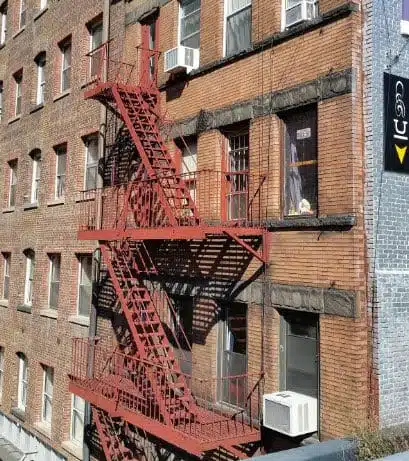Fire Safety for Seniors in Apartments
Posted in Fire safety tips for seniors and adults in NYC apartments.
While building material and fire prevention technologies have vastly improved over the centuries, structural fires remain almost as prominent a threat to New Yorkers today as they did during the city’s first years of settlement.
The FDNY responded to more than 27,000 structural fires in 2018, and while firefighters reached these fires with incredible speed (average response time was four minutes and 23 seconds,) the scope and impact of these incidents cannot be overstated.

“Fire escapes can prove challenging for seniors with limited mobility.”
Photo courtesy of Krobbins1949 via morguefile.com
In an effort to protect yourself and your neighbors, take some time to consider the following fire safety advice:
Plan Ahead
Fires can’t always be prevented, but residents can take steps to ensure they know what to do during an emergency. Ask yourself:
When did I last check my smoke and Carbon Monoxide Detectors?
Smoke alarms are a building’s first line of fire defense, so keeping them powered with fresh batteries is critical. Change your smoke and Carbon Monoxide detector batteries twice a year during daylight savings. If you don’t remember when they were last changed, change them now!
How do I leave the building in case of a fire?
All residential buildings should have at least two exits in the event of a fire, however, they will only work if the paths are clear, accessible and residents are physically capable of using the exit. Residents unable to use an emergency exit due to physical obstructions or mobility limitations should contact an elder care specialist with their family for guidance.
Is my building fireproof?
Larger apartment buildings (typically 6 floors or higher) are designed with a degree of fireproofing that should isolate most fires to a specific floor or apartment. Contacting your building management or local fire department to learn these details can play a major role in how you should react during a fire.
Are there fire hazards in my home?
Common household fire hazards include damaged or cracked electrical wires, extension cords plugged into large appliances, stacks of paper and other flammable materials and space heaters. By removing these safety concerns, you are ensuring the safety of yourself and your neighbors – don’t be shy about asking for help to move or remove hazards!
What’s coming with me?
If you need to evacuate a burning building, DO NOT stop to collect sentimental or valuable objects. Instead, consider having a “go bag” near your door with emergency supplies you might need in the hours following a fire emergency, including medication, prescription documents, copies of valuable documents, written contact information and personal identification. Click here for a full go-bag inventory
In Case of Fire
In your apartment
If there is a fire in your apartment or your smoke alarm goes off, remain calm – do not try to fight a major fire. Simply collect your go-bag, close as many doors behind you as possible and exit the building using the stairs, then contact 911 and report the fire from a safe distance.
In a non-fireproof building
Follow the same plan as above. Be sure to remain low to the ground as you exit, as the air will be cleaner near the floor. Fires in non-fireproof buildings can spread quickly, so be sure to alert others to the presence of fire as you exit.
In a fireproof building
If you live in a large apartment building, try to determine where the fire has occurred. If the fire is not in your apartment and little to no smoke is entering your apartment, it is generally safer to stay put, call 911 and tell them where you are in the building and block your apartment’s door to the hallway with wet towels, sheets or duct tape. Once in contact with 911 follow the dispatcher’s directions.
You can open your windows slightly for air circulation, but do not break your windows, as you may need to close them if the fire moves.
SelectCare hopes you find this information useful. If you or a loved one have concerns about fire safety in a long-time home, now is the time to call SelectCare, request an in-home care guide or emergency preparedness packet.
SelectCare’s team of home health care experts have helped New Yorker find peace of mind, providing comprehensive in-home care, community engagement and emergency preparedness assistance for more than 30 years.
